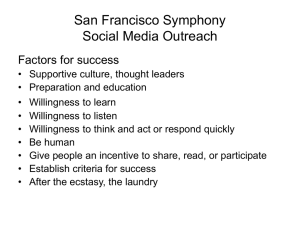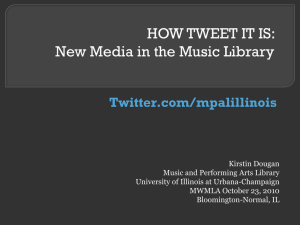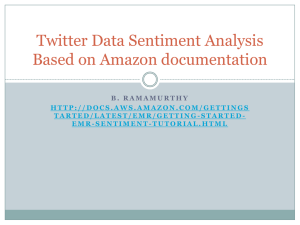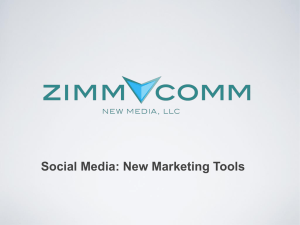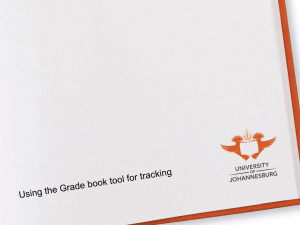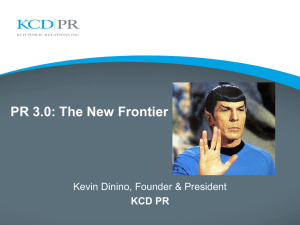evaluating the effective use of twitter in higher education
advertisement
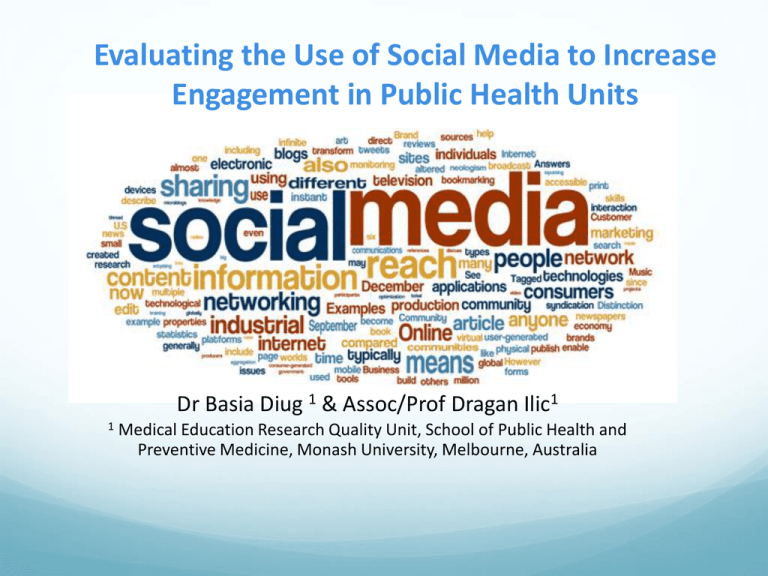
Evaluating the Use of Social Media to Increase Engagement in Public Health Units Dr Basia Diug 1 & Assoc/Prof Dragan Ilic1 1 Medical Education Research Quality Unit, School of Public Health and Preventive Medicine, Monash University, Melbourne, Australia WTH?… Is Social Media & Why Me! Definition: Create and share content or to participate in social networking E.g. Youtube, Facebook, Twitter Who is Accessing the Internet minor trend: as age 100 % of Users 80 60 40 20 0 14-19 20-29 30-39 40-49 Age Bracket 50-64 65+ Source: Yellow Social Media 2013 How often is social media used? Do not use social media More than five times a day A few times a week Never Everyday Once a Week Most days Less than weekly Source: Yellow Social Media 2013 H/T: Hugh Stephens 100 80 60 40 20 0 Which platforms are most used WHY ‘TWEET’ IN PUBLIC HEALTH Public health teaching is challenging as it focuses on prevention rather than intervention. • Twitter has a constant feed to the most current research, news and opinions of experts as well as organisations. • # let’s you search by theme • Our recommendations included: • • • • • • @RobinBellAus (guest lecturer), @BasiaDiug (unit coordinator), @theMJA, @WHO @Monash_SPHPM @MERQMU AIM: To evaluate whether the use of Twitter as an assessment is a successful tool in increasing student engagement with staff, peers and public health concepts METHODS Incorporate interactivity Twitter activity worth (2%) into a core public health unit. Tasks included: 1) Play ‘dumb ways to die’ health promotion game and tweet your character’s demise 2) Students identify a public health issue in their daily lives by posting a photo, image or link to a journal article of interest 3) Getting students involved in the wider public health conversation by following recommended Twitter accounts and using #sphpm Activity 1: Public Health Everyday With the person next to you discuss examples of public health that you see every day. Describe on for each scenario: 1. When you are commuting to this conference 2. At your hotel 3. Within the media Questions to discuss: How difficult was to come up with public health examples? What are the different public health initiatives that effect our everyday lives? What role does the media play in public health? Give both a positive and negative example 13 RESULTS Student cohort: Bachelor of Biomedical Science Total of 297 students of which 236 completed all Twitter-related learning activities (79.4%) 90% of students had previously used some form of social media All questions posed were either yes/no or used the Likert scale (1=strongly disagree to 5=strongly agree). Table 1. Use of Twitter in Higher Education Variable Prior use of social media N (%) Yes 260 (87.5) No 3 (1.0) 34 (11.5) No response Previous use of social media * Facebook 259 (87.2) 13 (4.4) 80 (26.9) Google + Instagram Tumbler 26 (8.8) 39 (13.1) Twitter Preferred mode of accessing and using social media Computer 73 (24.5) Mobile device 146 (49.2) Both computer and mobile device 33 (11.1) None/no response 45 (15.2) Should social media be used in learning activities? Yes No No response 222 (74.8) 47 (15.8) 28 (9.4) * Note – Students may have listed more than one form of social media previously used Twitter & Grades: Students who completed the Twitter learning activity had significantly higher end-of-semester grades compared to those who did not complete the Twitter learning activity [MD=3.98, 95%CI 0.40-7.55] Social Media & Grades: No significant difference observed in regards to use of social media and end-ofsemester grades [MD=4.28, 95%CI -0.16- 8.59]. Appropriateness: No significant difference also observed when comparing whether students believed that using twitter was appropriate for classroom learning and their end-of-semester and grades [MD=0.37, 95%CI -3.47- 4.21] Student Attitudes Overall were positive towards the use of social media in the learning environment. Students believed that the learning tasks using Twitter (Figure 1): 1) Enabled greater accessibility to staff; 2) Unique method of promoting public health; & 3) Facilitated collaboration with peers. Student Attitudes between those who completed and did not complete the activity Figure 2: Comparison of student attitudes There was a significant difference with respect to: 1. Promoting public health [MD=0.547, 95%CI 0.21- 0.94]; 2. Facilitating collaboration with peers [MD=-1.78, 95%CI -1.66 -1.89]. 3. No difference was observed regarding accessibility to staff [MD=0.25, 95%CI 0.11-0.61]. Student Attitudes between previous use of twitter Figure 3: Comparison of student attitudes who used twitter previously Students who were previous twitter uses had: Greater belief that the tasks would provide greater accessibility to staff when compared to nonusers, [MD=-0.36, 95%CI 0.65- 0.07]. However, no difference was observed in attitudes between previous twitter users and nonusers with respect to: Promoting public health, [MD=-0.16, 95%CI -0.460.12], Facilitating collaboration with peers, [MD=0.25, 95%CI -0.60- 0.08]. https://twitter.com/search?q=% 23sphpm&src=typd Lessons Learnt Social media can be difficult to use without instruction. E.g. Only 27% of Twitter’s users under 18-29 - don't assume knowledge. Scaffold and model – guide students. Be involved FUTURE DIRECTIONS To incorporate this activity into more units with a focus to increased interaction and recent journal articles and media articles. Develop skills and idea e-professionalism Follow us on Twitter: @basiadiug @draganilic99 @Monash_SPHPM @MERQMU #sphpm

